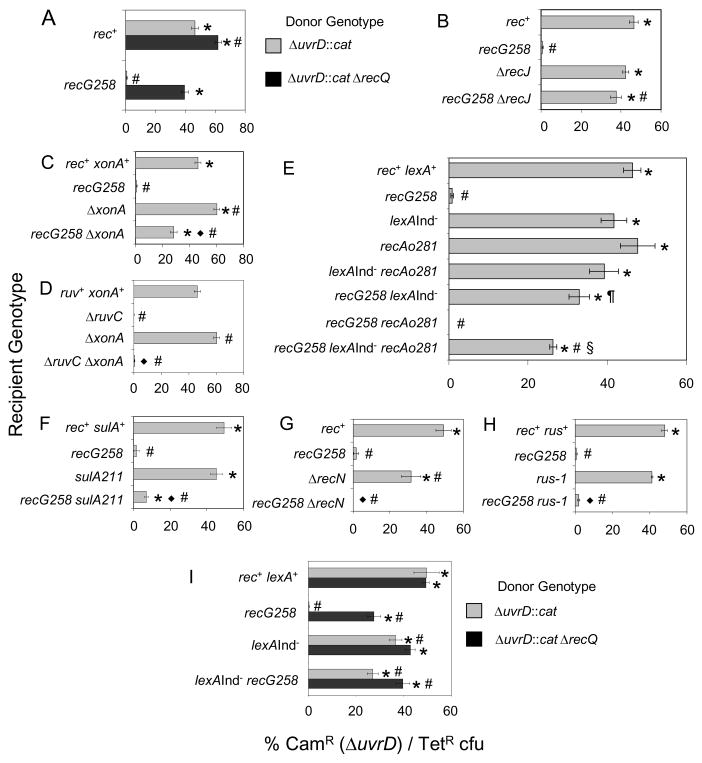Fig. 2.
Roles of recombination proteins and the SOS response in the death of recG uvrD cells. Data are results of co-transduction experiments as described in Fig. 1. (A) RecQ is required for recG ΔuvrD inviability. ΔuvrD and ΔrecQ alleles can be cotransduced together into recG258 recipient cells (SMR10419, donor strain SMR9812), but the ΔuvrD mutation alone (donor SMR9811) cannot. rec+ positive-control recipient, SMR6319. (B) RecJ is required for recG ΔuvrD inviability. ΔuvrD can be cotransduced into both ΔrecJ (SMR10434) and ΔrecJ recG258 (SMR10439) recipients. (C) ExoI is partially required for recG ΔuvrD inviability. ΔuvrD can be cotransduced into a ΔxonA recipient (SMR10395) efficiently, and a ΔxonA recG258 recipient (SMR10438) with intermediate efficiency. (D) ExoI is not required for inviability of ΔruvC ΔuvrD cells. ΔuvrD cannot be cotransduced into a ΔxonA ΔruvC recipient (SMR10417). ΔxonA positive control, SMR10395; ruvC negative control, SMR10408. (E) The SOS response, SOS-induced levels of RecA, and induction of another SOS gene(s) promote recG ΔuvrD inviability. Efficient cotransduction of ΔuvrD into “SOS-off” lexA(Ind−) (SMR9801), recAo281 (SMR9809) cells which produce SOS-induced levels of RecA, lexA(Ind−) recAo281 (SMR9805), and lexA(Ind−) recG258 (SMR10440) recipients, indicates that shutting off the SOS response via the lexA(Ind−) mutation partially restores viability to recG ΔuvrD cultures. Cotransduction efficiency is partially reduced from the level in lexA(Ind−) recG258 in a lexA(Ind−) recAo281 recG258 recipient (SMR10441), but is not abolished as in recAo281 recG258 (SMR10442) and recG258 (SMR10419). Therefore, SOS-induced levels of RecA account for some but not all of the contribution of the SOS response to recG ΔuvrD inviability. (F) SulA contributes little to recG ΔuvrD inviability. ΔuvrD is cotransduced poorly into a sulA211 recG258 recipient (SMR10443). sulA211 positive control, SMR9837. (G) RecN is not required for recG ΔuvrD inviability. ΔuvrD cannot be cotransduced into a ΔrecN recG258 recipient (SMR10734). ΔrecN positive control, SMR10730. (H) Activation of expression of Rus endonuclease by the rus-1 mutation does not restore viability to recG ΔuvrD cells. ΔuvrD cannot be cotransduced into recG258 rus-1 recipients (SMR10746). rec+ rus+ control, SMR10743; rus-1 positive control, SMR10744; recG258 negative control, SMR10745. (I) RecQ promotes recG ΔuvrD inviability wholly or partly independently of induction of the SOS response. ΔuvrD and ΔrecQ alleles confer greater viability when cotransduced together into recG258 lexA(Ind−) recipient cells (SMR10440, donor strain SMR9812) than the ΔuvrD alone (donor SMR9811), implying that ΔrecQ promotes recG ΔuvrD inviability wholly or partly independently of the LexA/SOS response. Mean ± SEM of 3 experiments (A–I). * indicates a significant difference from recG; # indicates a significant difference from rec+ (A–I). ◆ indicates a significant difference of each double mutant tested from the following isogenic single mutant: ΔxonA (C, D), sulA (F), recN (G), and rus-1 (H). In (A) recG cotransduced with ΔuvrD ΔrecQ is significantly different from rec+ cotransduced with same. In (E), the § indicated strain is significantly different from all others in the panal while the ¶ indicated strain is significantly different from the lexA(Ind−) single mutant among mutants carrying the lexA(Ind−) allele. In (I) lexA(Ind−) recG cotransduced with ΔuvrD ΔrecQ is significantly different from the same strain cotransduced with ΔuvrD alone. It is also significantly different from recG cotransduced with the ΔrecQ ΔuvrD donor.

